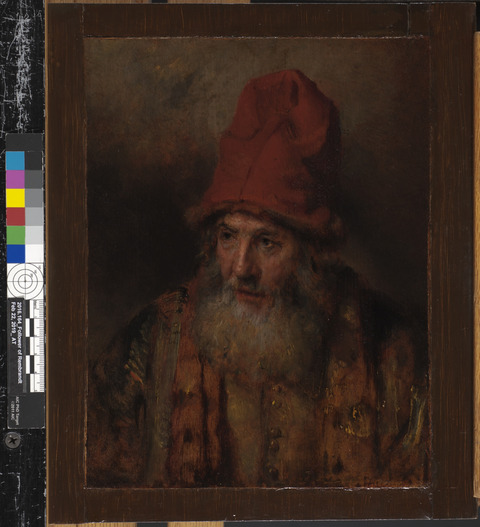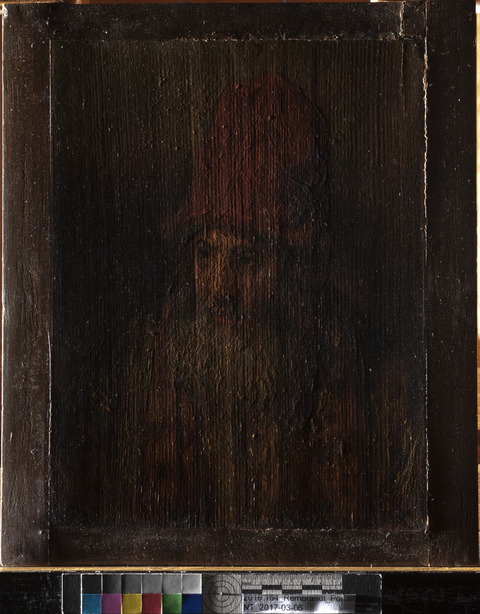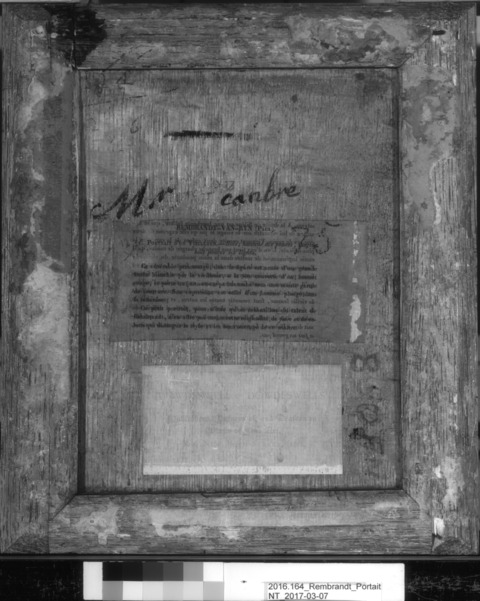Overview
Accession number: 2016.164
Artist: Workshop of Rembrandt van Rijn
Title: Old Man with a Tall, Fur-Edged Cap
Materials: Oil (untested) on eastern Baltic oak panel
Date of creation: About 1650
Previous number/accession number: C10062
Dimensions:
24.7 × 19 cm (original panel)
28.7 × 24.3 cm (panel with additions)
Conservator/examiner: Roxane Sperber
Examination completed: 2018
Distinguishing Marks
Front:
None
Back:
Item 1. “850 FN” handwritten in black paint, lower-right corner of original panel
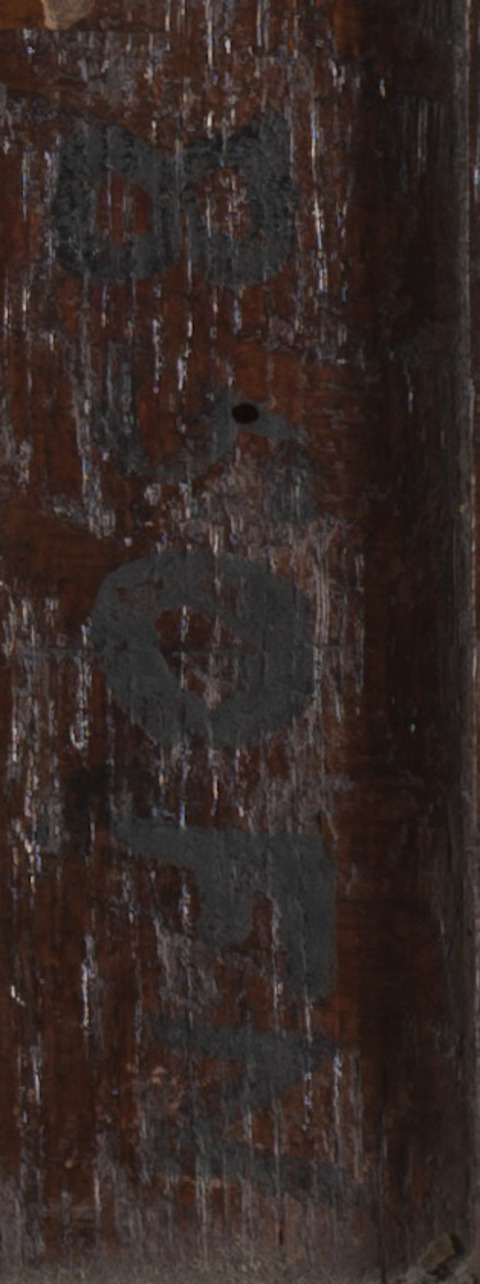
Item 2. " Mr. ___canbre" handwritten in black paint; above top label
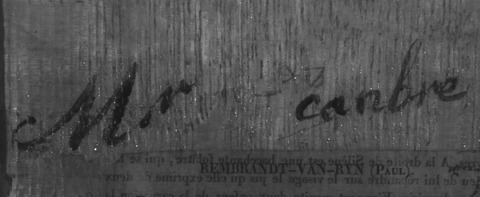
Item 3. off-white discolored label “From DOWDESWELL & DOWDESWELLS,
/LIMITED,/ Publishers, Valuers of, and Dealers in/ Works of Fine Art,/ 160, NEW BOND STREET, 160,/ LONDON, W.”

Item 4. paper auction label (from 1827 Bonnemaison auction catalogue) covered in degraded varnish that makes it appear dark brown (tech. fig. 4)
“REMBRANDT VAN-RYN (PAUL)./ 71. PORTRAIT D’UN VIEILLARD –Bois; hauteur dix pouces, largeur/ huit pouces six lignes./ Ce vénérable personnage, dont la figure est ornée d’une grande/ barbe blanchie par la vieillesse, a la tête couverte d’un bonnet/ rouge, et porte un juste-au-corps boutonné sous une mante garnie/ de fourrure. Son expression est celle d’un homme plongé dans/ la réflexion/.
Ce petit portrait, pour n’être qu’un échantillon du talent de/ Rembrandt, n’en offre pas moins cette originalité de faire et de co-/loris qui distingue le style et les bons ouvrage de ce maître”
Item 5. upper-right corner of French label “75” graphite or black chalk.
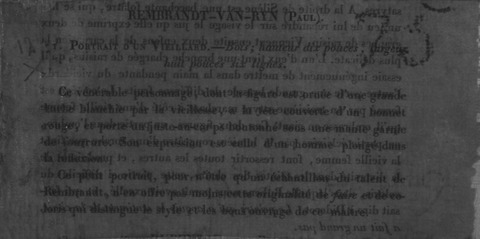
Item 6. “Prix 1000 francs” handwritten in brown ink vertically on the right side of the French label.

Summary of Treatment History
Physical evidence suggests the painting has undergone numerous previous interventions. The edges of the panel appear to have been cut with a precision woodworking tool, suggesting they were trimmed before wood additions were added to all four sides of the panel. Evidence suggests this was likely carried out after 1827 and before 1906 (see Description of Support). Published images of the work from the first half of the twentieth century show a larger version of the painted image (tech. figs. 8, 9), suggesting the wooden additions were originally added to expand the image. Dr. Clowes references the cleaning of the painting in Switzerland in a letter to Bert Newhouse dated 10 November 1952, which suggests the removal of the overpaint took place then.1
Documentation suggests a series of condition assessments and treatments were carried out on the collection around the time the works were moved from the Clowes' residence to the IMA in 1971. A condition report by Paul Spheeris in October of that year, likely carried out before the paintings were relocated, described the painting as not needing treatment. He did note a small crack in the frame.2
A second condition assessment was carried out upon arrival of the paintings at the IMA. This assessment describes the work as in good condition, and no treatment was deemed necessary. An X-radiograph of the painting was made at this time.3 In 1974, a condition assessment, treatment, and investigation of the collection was carried out by the Intermuseum Conservation Association at Oberlin College. This document describes this painting as having a natural resin varnish that was glossy and fingermarked. However, no treatment was recommended.4
In 1996, a memorandum summarizing treatment and examination of the Clowes Collection from the time it entered the collection recorded that no treatment was carried out on the painting up until that point but that it was the subject of a major investigation.5A full investigation and treatment of the painting, including removal of discolored varnish and retouching, the application of a new varnish, and inpainting, was conducted in 2018/19.6 The work was examined in the Clowes Collection annual survey from 2011 to 2020.
Current Condition Summary
The work is in structurally stable condition; however, there is severe abrasion throughout the painting, likely due to a previous harsh cleaning. The abrasion is particularly severe on the edges of the panel, perhaps suggesting the removal of the painting extensions was pursued at the expense of the original paint layer. The painting has been recently restored and thus is in good condition.
Methods of Examination, Imaging, and Analysis
| Examination/Imaging | Analysis (no sample required): | Analysis (sample required): |
|---|---|---|
Unaided eye | Dendrochronology | Microchemical analysis |
Optical microscopy | Wood identification | Fiber ID |
Incident light | Microchemical analysis | Cross-section sampling |
Raking light | Thread count analysis | Dispersed pigment sample |
Reflected/specular light | X-ray fluorescence spectroscopy (XRF) | Fourier-transform infrared spectroscopy (FTIR) |
Transmitted light | Macro X-ray fluorescence scanning (MA-XRF) | Raman microspectroscopy |
Ultraviolet-induced visible fluorescence (UV) | ||
Infrared reflectography (IRR) | Gas chromatography–mass spectrometry (GC-MS) | |
Infrared transmittography (IRT) | Scanning electron microscope -energy dispersive X-ray spectroscopy (SEM-EDS) | |
Infrared luminescence | Other: | |
X-radiography |
Technical Examination
Description of Support
Analyzed Observed
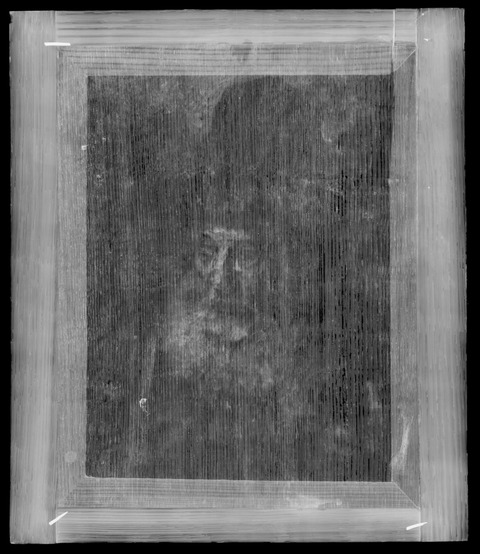
Material (fabric, wood, metal, dendrochronology results, fiber ID information, etc.):
The painting is on a single eastern Baltic oak (Quercus spp.) board with vertically oriented grain (tech. fig. 6). The board was derived from a slow-grown and straight-grained timber. The piece of wood is radially sawn as evidenced by ray flecks on the back of the panel and the vertically oriented and evenly spaced tree rings (tech. fig. 7). This accounts for the panel’s very flat camber. 7

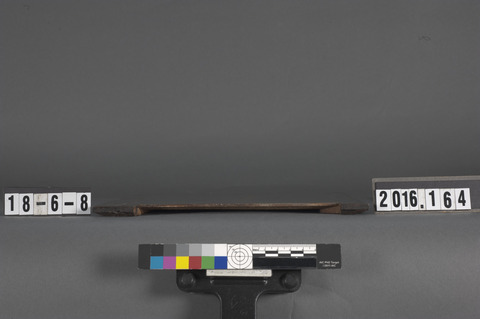
The grain is prominent and can be observed on both the painted and unpainted side of the panel, especially in raking light. Radio-opaque material from the ground and imprimatura fill the interstices of the grain, allowing it to be observed in the X-radiograph (tech. fig. 6).
Dendrochronological analysis by Ian Tyers found the heartwood from the tree used for the panel dates to 1618. The minimum expected number of sapwood rings likely to be missing from a board of eastern Baltic-sourced timber is eight, giving a terminus post quem for the painting of about 1626. Eastern Baltic oak disappears almost entirely from Western Europe around 1650; therefore, the most likely date for the painting is between 1626 and 1650.8
Characteristics of Construction / Fabrication (cusping, beveled edges of panels, seams, joins, battens):
The original panel has not been thinned, and regular, straight saw marks perpendicular to the grain are visible on the back. These are consistent with technology of the first or second decade of the seventeenth century, a period that saw the emergence of machine-powered saw mills capable of processing oak in northern Europe.9
The original panel has been enlarged with strips of wood on all four sides (see tech. fig. 10). The wood additions on the left and right sides of the panel are 2.6 cm wide and have vertically oriented wood grain. The wood additions on the top and bottom of the panel are 2 cm wide and also have vertically oriented wood grain. The strips on the left and right extend the full height of the addition, while the top and bottom additions are fitted between the left and right strips. The outer edges of all four additions are beveled. A second set of wooden strips is attached at the back and covers 1.5 cm of the original panel. The corners of the inner strips are mitered and serve to hold the panel in the construction. The inner strips were glued to the outer strips, probably before being fitted to the panel.
The panel has a complex physical history. An 1827 auction catalog entry lists the work as “hauteur dix pouces, largeur/ huit pouces six lignes,” which is equivalent to 10 × 8.5 in (25.4 × 21.6 cm).10 The use of the ligne, a small and specific measurement, suggests these dimensions are likely precise and probably correspond to the original dimensions of the panel.11 These measurements are slightly larger than the current dimensions of the original panel, suggesting it was trimmed before additions were added after 1827. The edges are very straight and appear to have been cut with a precision woodworking tool. This was likely to facilitate an accurate fit to the additions, which are also precisely machined. The edges of the panel have been beveled to fit the additions.
A catalog entry from 1906 lists the work as “0m, 29 × 0m, 245”,12 which is equivalent to 11.4 × 9.6 in (28.9 × 24.3 cm), the size of the current panel with the additions (Table 1). The corresponding illustration from this entry also shows the work with an extended composition (tech. fig. 8), suggesting the additions were originally painted to enlarge the image. This intervention extended the composition on all four sides, adding to the figure’s shoulders and buttons. An illustration in a 1934 auction catalog (tech. fig. 9) shows the painted extensions over the edges of the addition. This is particularly visible in the lower-left corner. The paint handling is quite clumsy and was probably quite easily differentiated from the original. This probably led to it being removed in 1952.13 The painting is documented in its current configuration in 1956.14
Workshop of Rembrandt, Old Man with a Tall, Fur-Edged Cap, about 1650, while in the Collection of Leopold Hirsch, London. Wilhelm von Bode, Cornelis Hofstede de Groot, and Florence Simmonds, The Complete Work of Rembrandt: History, Description, and Heliographic Reproduction of All the Master’s Pictures with a Study of His Life and His Art (Paris: Charles Sedelmeyer, 1897), 8: 137.
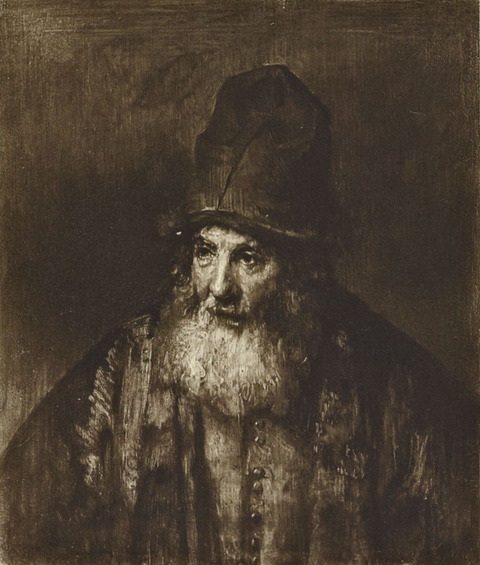
Workshop of Rembrandt, Old Man with a Tall, Fur-Edged Cap, about 1650, while in the Collection of Leopold Hirsch, London. Wilhelm von Bode, Cornelis Hofstede de Groot, and Florence Simmonds, The Complete Work of Rembrandt: History, Description, and Heliographic Reproduction of All the Master’s Pictures with a Study of His Life and His Art (Paris: Charles Sedelmeyer, 1897), 8: 137.
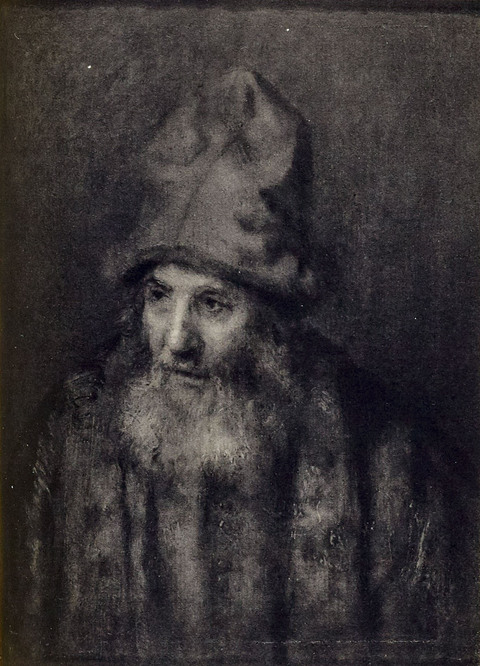
Interestingly, the painting was originally purchased by Dr. Clowes in 1934 and remained in his collection until he sold it in 1944. However, after Bert Newhouse had the painting cleaned in Switzerland in 1952, Clowes’s interest was piqued and he repurchased it.15
| Year | Listed Dimension | Conversion | ||||
|---|---|---|---|---|---|---|
| H | W | H (in) | W (in) | H (cm) | W (cm) | |
| 1827 | hauteur dix pouces | largeur huit pouces six lignes | 10 | 8.5 | 25.4 | 21.6 |
| 1906 | 0m, 29 | 0m, 245 | 11.4 | 9.6 | 29 | 24.5 |
| 1909 | 11 in (0.279) | 19 in (sic) (0.483) | 11 | 19 (sic) | 27.9 | 48.3 (sic) |
| 1921 | 0, 29 | 0, 245 | 11.4 | 9.6 | 29 | 24.5 |
| 1923 | 11 ½ in | 9 ½ in | 11.5 | 9.5 | 29.2 | 24.1 |
| 1934 | 10 ½ in | 9 in | 10.5 | 9 | 26.7 | 22.9 |
| 1937 | 10 ¾ in | 9 in | 10.75 | 9 | 27.3 | 22.9 |
| 1956 | 11 ½ in | 9 ¾ in | 11.5 | 9.75 | 29.2 | 24.8 |
| 1959 | 9 ¾ in | 7 1/2 in | 9.75 | 7.5 | 24.8 | 19.1 |
| Current | ||||||
| w/o additions | 9.7 | 7.5 | 24.7 | 19 | ||
| w/ additions | 11.3 | 9.6 | 28.7 | 24.3 | ||
Table 1: Recorded dimensions of the panel over time
Thickness (for panels or boards):
Panel additions: 1 cm (tapered edge 0.5 cm)
Original panel: 0.5 cm (tapered edge 0.3 cm)
Production/Dealer’s Marks:
None
Auxiliary Support:
Original Not original Not able to discern None
Four strips of wood are adhered to the outer edges of the panel (tech. fig. 10).

Attachment to Auxiliary Support:
Four nails, one in each corner, hold the outer strips of the auxiliary support together and can be seen in the X-radiograph and on the back of the painting. Glue was used to adhere the wood additions to the edges of the painting.
Condition of Support
The panel is in generally good structural condition. The camber of the panel is flat and there is no evidence that the additions are constraining the panel’s natural movement. There is a small split in the upper-right corner that extends through both the addition and the original panel. The split does not appear to be changing, as it looks the same as in a historical image from 1956. There are two small holes on the back of the panel that could possibly be from insects. However, there are only two and they are quite evenly spaced, suggesting they are from a previous attachment or framing mechanism. The top addition, to the left of the split, was removed during the technical examination and was secured with fabric strips to allow for future removal.
Description of Ground
Analyzed Observed
The ground is a thinly applied, off-white color composed of calcium carbonate likely in an animal glue binder (untested) (tech. fig. 12). This ground structure is typical of seventeenth-century Dutch panel paintings and is consistent with that found on other panels from Rembrandt’s studio.16
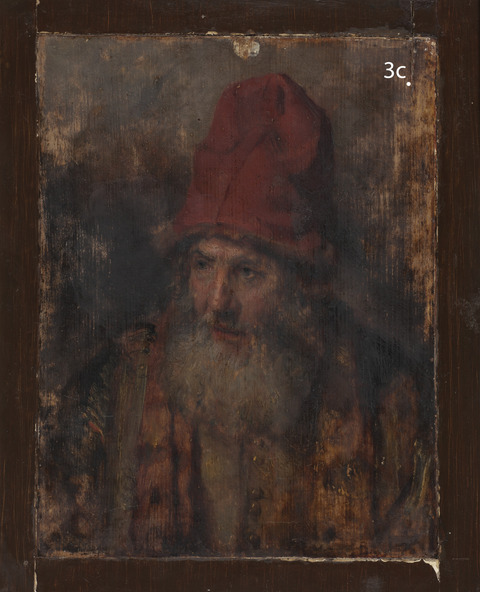
There is a light brown imprimatura composed of lead white, calcium carbonate, and ochre pigments applied to the entire surface of the panel (tech. figs. 15, 16). It is likely bound in oil and served to tone the ground and seal it. A study of Rembrandt’s work on panel found a thin, light brown coating to be present over the chalk ground in all cases.17
Materials/Binding Medium:
Calcium carbonate / lead white
Color:
Off-white
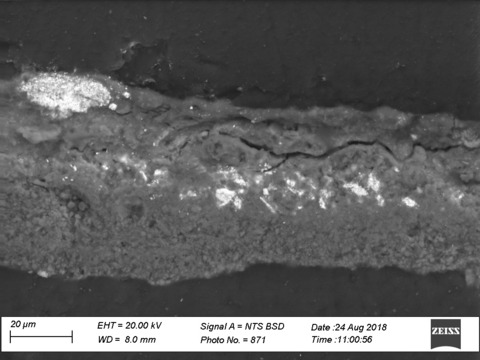
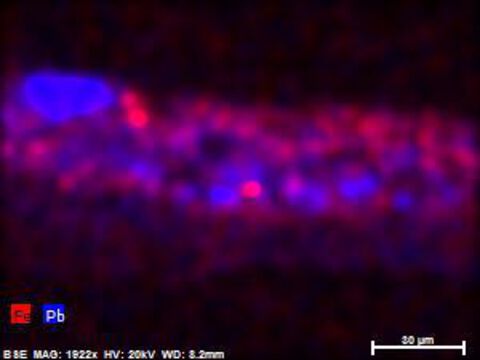
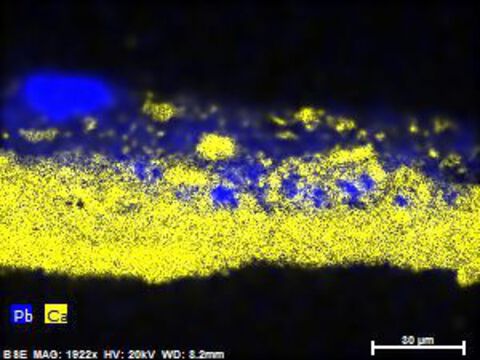
Application:
The ground was applied thinly to even the surface of the wood. The ground and imprimatura fill the interstices of the wood grain and thinly skim the peaks of the grain so as to reduce, but not eliminate, the texture of the support. This can be observed in the X-radiograph as the X-ray opaque ground and imprimatura fill the interstices of wood grain to create a smooth painting surface. However, due to the prominent grain, the peaks of the wood are not covered by as thick a layer of ground as the dips. This differential makes the grain clearly visible in the X-radiograph.
A ground layer has also been applied to the wood additions.
Thickness:
Thin
Sizing:
A layer of glue size (untested) is present at the bottom of the ground and fluoresces under ultraviolet-induced visible fluorescence (tech. fig. 17).
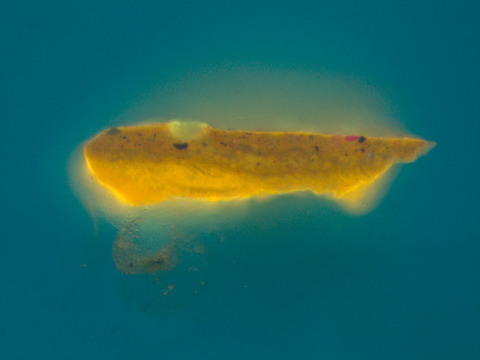
Character and Appearance (Does texture of support remain detectable / prominent?):
The texture of the support remains prominent through the paint layers. This is easily observed in raking light.
Condition of Ground
The ground is in good condition. There is a subtle craquelure pattern consistent with the age of the painting. There are no major losses, but a series of small losses exist along the edges of the panel, probably sustained when the panel was trimmed in preparation for the additions to be added.
There are losses to the ground on the additions along the lower-left join, the upper-right edge of the lower addition, and the lower edge of the upper addition.
Description of Composition Planning
Methods of Analysis:
Surface observation (unaided or with magnification)
Infrared reflectography (IRR)
X-radiography
Analysis Parameters:
| X-radiography equipment | GE Inspection Technologies Type: ERESCO 200MFR 3.1, Tube S/N: MIR 201E 58-2812, EN 12543: 1.0mm, Filter: 0.8mm Be + 2mm Al |
|---|---|
| KV: | 20 |
| mA: | 3.0 |
| Exposure time (s) | 60 |
| Distance from X-ray tube: | 36” |
| IRR equipment and wavelength | Opus Instruments Osiris A1 infrared camera with InGasAs array detector operating at a wavelength of 0.9 µm – 1.7 µm |
Medium/Technique:
The composition was sketched over the warm, brown imprimatura using a slightly darker brown paint (dead-coloring). There is no evidence that the artist sketched the image on the panel using dry media, although he may have been working freehand from a sketch.18 The dead coloring established the outlines of the man’s features, shadows of the face, shape of the hat, folds of the drapery, and gradient of the background with loose, confident brush strokes. This type of underpainting is typical of Rembrandt’s studio and has been noted in numerous technical publications about the master.19
The infrared reflectogram (tech. fig. 18) shows the brushy execution of the sketch, but the extensive use of infrared absorbing pigments leaves the image somewhat soft and blotchy. The infrared reflective ground is left exposed in areas of the face. This technique is visually reminiscent of the infrared images of Rembrandt’s heads of Christ.20 The effect appears at the transition from opaque paint to translucent glazes, or exposed ground, and is described as a “charred-edge” effect.21
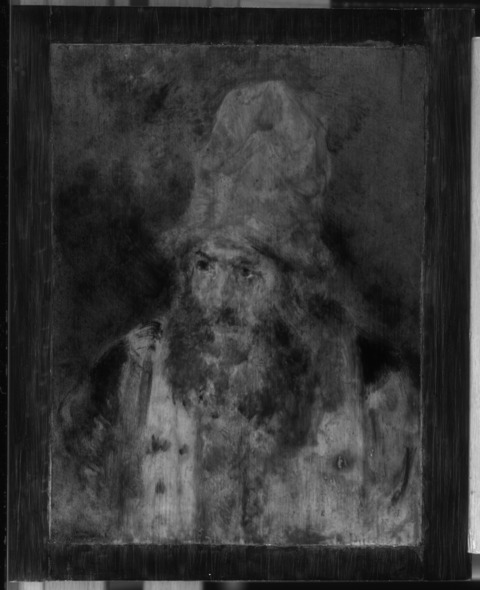
Pentimenti:
There are no pentimenti visible in IRR. The left pupil was originally a slightly rounder shape but was changed as the painting was worked up.
Description of Paint
Analyzed Observed
Application and Technique:
Loosely articulated paint layers were applied over the painted sketch. The form in the figure’s flesh was created using directly applied midtones and highlights over the washy brown underpainting, which was used to create the shadows (tech. fig. 19). Cool gray and warm pink tones were applied in short, alternating brushstrokes that were not blended (tech. fig. 20). Rather, exposed areas of the ground and imprimatura were left visible and act as a translucent midtone (tech. fig. 19).22 Light-pink and light-yellow highlights were applied in thick, opaque paint to the forehead and bridge of the nose. Where a warmer shadow tone was needed—such as between the lips of the figure—the underpainting was reinforced with a transparent red glaze, probably using a red lake pigment.
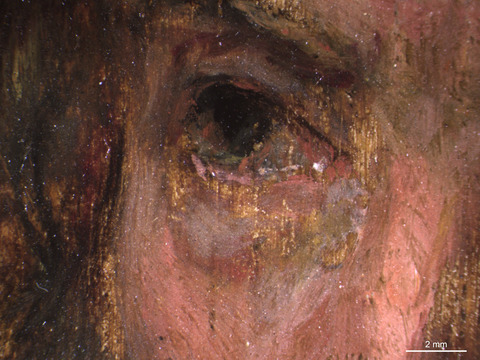
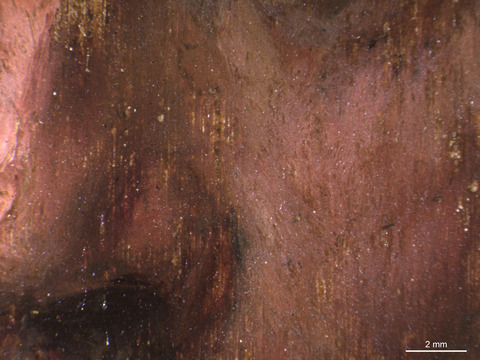
The sitter’s facial hair is articulated with alternating colors painted to mimic the curls of his beard (tech. fig. 21). On the gray midtone, bright white strokes are applied under the chin. Cool gray and black strokes are then used to articulate the shadows in the beard.
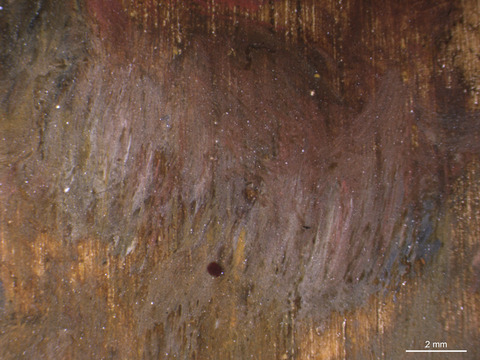
The hat was painted following the contours of the underpainting. The midtones and highlights were painted with opaque red paint, while the areas of shadow on the right side of the hat were applied with a transparent red glaze over the underpaint. Refining details in the hat were also painted with a red glaze.
In the cloak, large swaths of the underpainting were left exposed while the highlights were built up selectively with a cool gray color and bright yellow highlights in dabs of impasto (tech. fig. 22). Black paint was used to reinforce details in the shoulders as well as the beard and hat (tech. fig. 23).
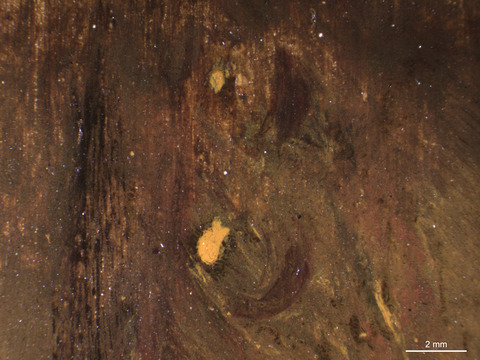
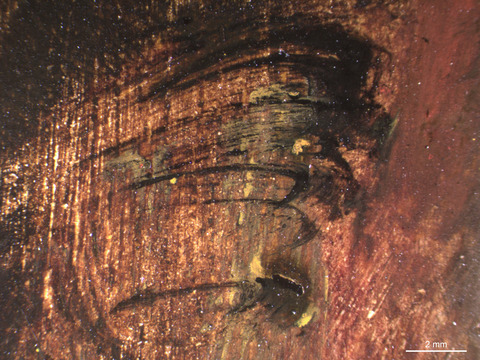
The materials and painting technique are consistent with Rembrandt and his studio.23 The handling is applied with less confidence than one might expect from the master, but the extent of abrasion detracts from the quality of the work. This painting may be that of a talented student carefully following the master’s technique.
Painting Tools:
Small to medium-sized brush
Binding Media:
Oil (untested)
Color Palette:
The artist used a limited palette consisting of lead white, calcium carbonate, earth pigments including ochres and umbers, bone black, and likely red lake pigments. Interestingly, no vermilion is present in the figure’s hat or anywhere else in the painting. Rather, it appears the artist used red ochre and red lake to achieve the desired effect. This is consistent with the Berlin version of the work, which also does not contain vermillion in the hat of the figure (see catalogue entry, fig. 1).24 The sparing use of vermilion was a feature of Rembrandt’s studio, which favored instead a combination of red earth and red lake where a strong red was needed.25
A cross section sample from the background confirms the artist’s use of bone black by the presence of calcium and phosphorous in the black pigments (tech. fig. 26). The iron distribution map shows the use of ochre pigments in the imprimatura and paint layer (tech. fig. 27), with a higher concentration in the paint layer. A deep red particle on the right side of the cross section fluoresces bright pink under ultraviolet-induced visible fluorescence. This suggests the red lake may be madder (see tech. fig. 17).
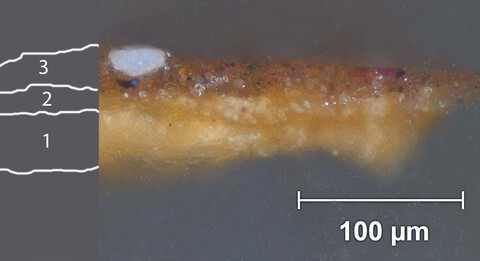



XRF Analysis:
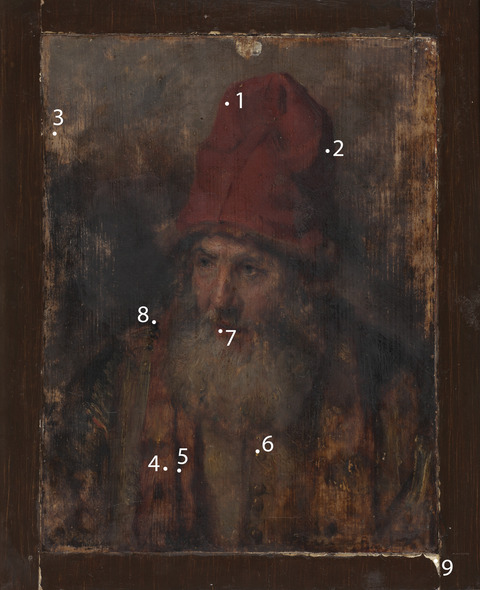
| Sample | Location | Elements | Possible Pigments |
|---|---|---|---|
| 1 | Red hat highlight (5.5 cm down, 11 cm from left) | Major: Fe, Pb Minor: Ca Trace: Mn, K, Cu | Iron oxide (earth pigments including umber), lead white, calcium carbonate (from ground). |
| 2 | Red hat shadow (7 cm down, 16.5 cm from left) | Major: Fe, Pb Minor: Ca Trace: Mn, K, Cu | Iron oxide (earth pigments including umber), lead white, calcium carbonate (from ground). |
| 3 | Ground (7 cm down, 3 cm from left) | Major: Pb, Ca Minor: Fe Trace: Mn | Lead white, iron oxide (earth pigments including umber), calcium carbonate (from ground). |
| 4 | Brown imprimatura (23 cm, down 8 cm from left) | Major: Pb Minor: Ca, Fe Trace: Mn, Cu | Lead white, iron oxide (earth pigments including umber), calcium carbonate (from ground). |
| 5 | Brown sketch (23 cm down, 9 cm from left) | Major: Pb, Minor: Ca, Fe Trace: Mn, Cu | Lead white, iron oxide (earth pigments including umber), calcium carbonate (from ground). |
| 6 | Yellow button (22 cm down, 13 cm from left) | Major: Fe, Pb Minor: Trace: Ca, Ti, K | Lead white, iron oxide (earth pigments including umber and possible titanium impurity), calcium carbonate (from ground). |
| 7 | Red lip (16 cm down, 11 cm from left) | Major: Fe, Pb Minor: Trace: Ca, K | Lead white, iron oxide (earth pigments including umber), calcium carbonate (from ground). |
| 8 | Black stripe (16.2 cm down, 8 cm from left) | Major: Pb, Minor: Fe, Ca Trace: K, Mn, P, Cu | Iron oxide (earth pigments including umber), lead white, calcium carbonate (from ground), bone black |
| 9 | Ground addition (27 cm down, 12 cm from left) | Major: Ca Minor: Sr Trace: Fe, Pb | Calcium carbonate, trace of lead white, trace of iron oxide (earth pigments including umber). |
Table 2: Results of X-ray fluorescence analysis conducted with a Bruker Artax microfocus XRF with a rhodium tube, silicon-drift detector, and polycapillary focusing lens (̴ 100µm spot), 50 kV, 600 µA, no filter, He stream, 60 seconds.
*Major, minor, trace quantities are based on XRF signal strength not quantitative analysis
Surface Appearance:
The surface of the paint is somewhat textured, although cleaning abrasion from past interventions has destroyed some of the texture in the paint.
Condition of Paint
The paint layer has been severely abraded by past cleaning. The abrasion is especially severe around the edges of the picture where the paint has been abraded down to the ground layer (tech. fig. 29). Despite abrasion in the background, the figure is in generally good condition. This may be, at least in part, related to the removal of overpaint on the additions that was carried out between 1935 and 1956.
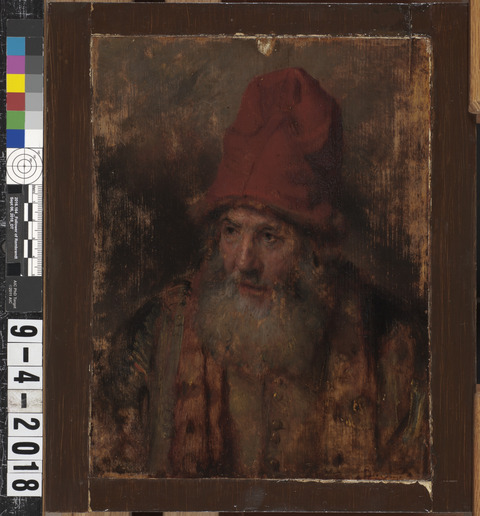
Description of Varnish/Surface Coating
Analyzed Observed Documented
| Type of Varnish | Application |
|---|---|
Natural resin | Spray applied |
Synthetic resin/other | Brush applied |
Multiple Layers observed | Undetermined |
No coating detected |
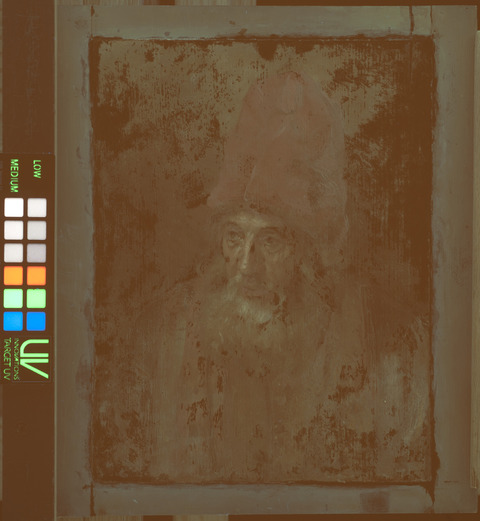
The painting has a brush varnish composed of 25% Laropal A81 and two layers of spray varnish composed of 25% Laropal A81. The varnish is saturating, but not applied so thickly as to obscure the impasto on the painting. During the 2018 treatment, a natural resin varnish, which coated the entire panel and additions, was removed from the panel but not removed from the additions.26 Therefore, there is a strong fluorescence under ultraviolet radiation in these areas (tech. fig. 30). The last treatment also left a thin residual varnish on the panel that, due to the severely abraded nature of the paint, was deemed best not to remove.
Extensive retouching from a previous treatment was removed during the 2018 treatment. Inpainting from the 2018 treatment is visible under ultraviolet radiation (tech. fig. 30).
Condition of Varnish/Surface Coating
After the 2018 treatment the painting has a clear, saturating varnish with an appropriate gloss. Inpainting is matched and well saturated.
Description of Frame
Original/first frame
Period frame
Authenticity cannot be determined at this time/ further art historical research necessary
Reproduction frame (fabricated in the style of)
Replica frame (copy of an existing period frame)
Modern frame
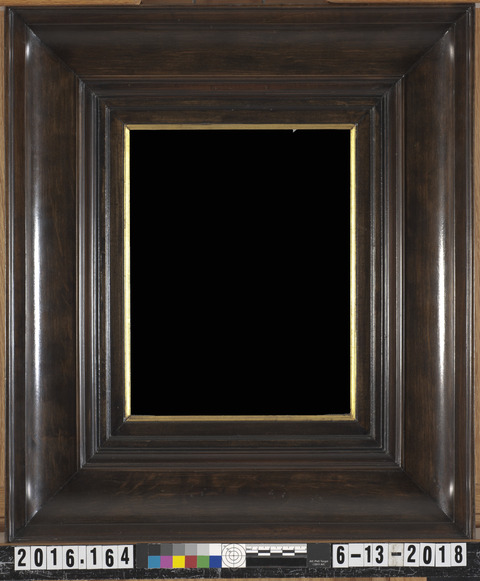

Frame Dimensions:
Outside frame dimensions: 45.4 × 39.3 cm
Sight size: 24.7 × 19 cm
Distinguishing Marks
(see tech. fig. 32)
Item 7. Frame off-white sticker, back lower-right corner, pen -“7 4”
Item 8. Frame off-white sticker, back upper-left corner, brown marker –"# 10062"
Item 9. Frame off-white label with red border, back center, stamped –“THE CLOWES FUND INCORPORATED/FINE ARTS DEPARTMENT/…14 SPRING HOLLOW ROAD” typed sticker over label “No. 38 – Rembrandt/ Portrait of an Old Man with a Tall Fur-Edged Cap”
Description of Molding/Profile:
The frame is a modern wooden frame composed of four members with mitered corner joins (tech. fig. 33). The surface has been treated with a dark brown wood veneer. The innermost decorative element is gilded. The rebate is lined with cork, which is brittle.
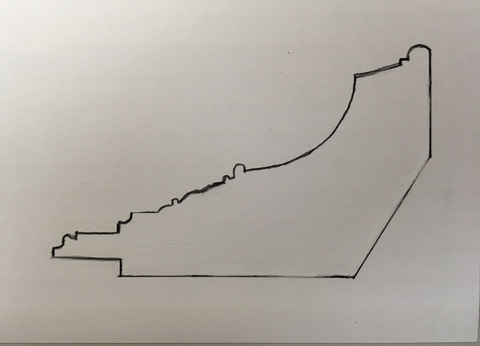
Condition of Frame
The frame is in excellent structural and aesthetic condition.
Notes
-
Letter from G.H.A. Clowes to Bert Newhouse, 10 November 1952, Correspondence Files, Clowes Registration Archive, Indianapolis Museum of Art at Newfields. ↩︎
-
Paul A.J. Spheeris, “Conservation Report on the Condition of the Clowes Collection,” 25 October 1971, Conservation Department Files, Indianapolis Museum of Art at Newfields. ↩︎
-
Martin Radecki, Clowes Collection condition assessment, undated (after October 1971), Conservation Department Files, Indianapolis Museum of Art at Newfields. ↩︎
-
Intermuseum Conservation Association, “Clowes Collection Conservation Report,” C10062 (2016.164), 8–10 April 1974, Conservation Department Files, Indianapolis Museum of Art at Newfields. ↩︎
-
Memorandum from Martin Radecki to Bret Waller, “Conservation Work on Clowes Fund Collection”. 16 February 1996. Conservation Department Files, Indianapolis Museum of Art at Newfields. ↩︎
-
Roxane Sperber,CON2018.166: Examination, Treatment Proposal, and Treatment Report, 2018, C10062(2016.164), Conservation Department Files, Indianapolis Museum of Art at Newfields. ↩︎
-
All information on the panel support derived from analysis by Ian Tyers. See Ian Tyers, “Tree-ring analysis and wood identification of paintings from the Indianapolis Museum of Art, Dendrochronological Consultancy Report 1082,” January 2019, p. 20, Conservation Department Files, Indianapolis Museum of Art at Newfields. ↩︎
-
Ian Tyers, “Tree-ring analysis and wood identification of paintings from the Indianapolis Museum of Art, Dendrochronological Consultancy Report 1082,” January 2019, p. 20, Conservation Department Files, Indianapolis Museum of Art at Newfields. ↩︎
-
Ian Tyers, “Tree-ring analysis and wood identification of paintings from the Indianapolis Museum of Art, Dendrochronological Consultancy Report 1082,” January 2019, p. 20, Conservation Department Files, Indianapolis Museum of Art at Newfields. ↩︎
-
The ligne is a historic unit of measurement used in France and Switzerland before the adoption of the metric system. One ligne is equivalent to 0.089 in or 2.256 mm. Rob Berkavicius, “Watch Movement Measuring Systems: The Origins of Watch Size Measurements,” 23 June 2009: http://members.iinet.net.au/~fotoplot/tech/wmms.html. ↩︎
-
A series of painted sketches on panel from Rembrandt’s studio, depicting the head of Christ, also conform to these dimensions. Mark Tucker, Lloyd DeWitt, and Ken Sutherland, “The Heads of Christ: A Technical Survey,” in Rembrandt and the Face of Jesus, ed. Lloyd DeWitt (New Haven: Yale University Press in association with the Philadelphia Museum of Art, 2011), 35. A survey from the Gemäldegalerie in Berlin of 16 wood panels classified as tronies show they also conform to these dimensions. Claudia Laurenze-Landsberg and Katia Kleinert, “Documentation Rembrandt—Old Man with a Red Cap III/417” (Gemäldegalerie Staatliche Museen zu Berlin, 2015), 9. Accessed 14 June 2018: https://rkd.nl/en/explore/technical/5010370?tmpl=pdf&pdf=3d1e48f7-7fc0-2ce2-09f4-c03e49a13aad. ↩︎
-
Wilhelm von Bode, Cornelis Hofstede de Groot, and Florence Simmonds, The Complete Work of Rembrandt: History, Description, and Heliographic Reproduction of All the Master’s Pictures with a Study of His Life and His Art (Paris: Charles Sedelmeyer, 1906), 8: 137. ↩︎
-
Letter from G.H.A. Clowes to Bert Newhouse, 10 November 1952, Correspondence Files, Clowes Registration Archive, Indianapolis Museum of Art at Newfields. ↩︎
-
W. R. Valentiner, Rembrandt and His Pupils, exh. cat. (Raleigh: The North Carolina Museum of
Art, 1956), no. 24. ↩︎
-
Letter from G.H.A. Clowes to Bert Newhouse, 4 April 1955, Correspondence Files, Clowes Registration Archive, Indianapolis Museum of Art at Newfields. ↩︎
-
David Bomford et al., Art in the Making: Rembrandt (London: National Gallery Publications, 1991), 27. ↩︎
-
Ernst van de Wetering, Rembrandt: The Painter at Work (Amsterdam: Amsterdam University Press, 2009), 21. ↩︎
-
According to Carel van Mander’s Schilder-boeck, copying techniques of the period included freehand copying directly onto panel, but only the most skilled artist could apply dead-coloring without a drawing. Jørden Wadum, “Uncovering Rembrandt,” in Lene Bøgh Rønberg et al., Rembrandt? The Master and His Workshop. (Copenhagen: Statens Museum for Kunst, 2006), 130–131. ↩︎
-
David Bomford et al., Art in the Making: Rembrandt (London: National Gallery Publications, 1991), 32; Arie Wallert and Michel van der Laar, “Rembrandt Head of Christ: Some Technical Observations concerning Matters of Style,” in Rembrandt and His Circle: Insights and Discoveries, ed. Stephanie Dickey (Amsterdam: Amsterdam University Press, 2017), 217; Ernst van de Wetering, Rembrandt: The Painter at Work (Amsterdam: Amsterdam University Press, 2009), 23. ↩︎
-
Lloyd DeWitt, ed., Rembrandt and the Face of Jesus (New Haven: Yale University Press in association with the Philadelphia Museum of Art), 38, 208. ↩︎
-
Lloyd DeWitt, ed., Rembrandt and the Face of Jesus (New Haven: Yale University Press in association with the Philadelphia Museum of Art), 38, 208. ↩︎
-
A similar technique is described in David Bomford et al., Art in the Making: Rembrandt (London: National Gallery Publications, 1991), 32–33. ↩︎
-
David Bomford et al., Art in the Making: Rembrandt (London: National Gallery Publications, 1991), 32–33. ↩︎
-
Ernst van de Wetering, A Corpus of Rembrandt Painting: A Complete Survey, vol. 6 (Dordrecht: Springer, 2015), 622. ↩︎
-
David Bomford et al., Art in the Making: Rembrandt (London: National Gallery Publications, 1991), 22. ↩︎
-
Roxane Sperber, “IMA Paintings Conservation Department Treatment Report, 2016.164,” January 2019, Conservation Department Files, Indianapolis Museum of Art at Newfields. ↩︎
Additional Images
